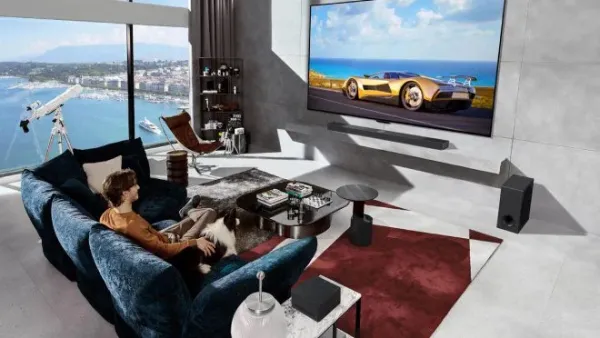
When Indian families choose a smart TV for familythey often think about size, value, and where they will watch it. Deciding on a 32-inch, 43-inch, or 55-inch TV isn’t just about what they like; it involves considering room size, budget, viewing habits, and family needs. Each size has its own benefits and drawbacks. This article examines these differences, including picture and sound quality, ease of use, cost and value, smart features, energy needs, and suitability for typical Indian family situations.
The screen size should match the distance people sit from it for a comfortable viewing experience. In smaller spaces like bedrooms or kitchens, where seating is usually 1.5 to 2.5 meters away, a 32-inch TV works well without overpowering the room. For living rooms where seating is 2.5 to 4 meters away, the 43-inch model strikes the right balance.

It’s large enough to show details on streaming services and sports, but still fits in the space. The 55-inch models are better for larger family rooms with viewing distances of 3.5 meters or more. They provide a more cinematic feel, enhancing the experience for movies and gaming. In many Indian homes with limited space, choosing a 55-inch TV can lead to compromises, like the TV dominating the room or seating being too close, making it hard to track details on the screen.
While screen size is eye-catching, picture quality depends on factors such as panel type, resolution, HDR processing, and upscaling capabilities. Most 32-inch TVs are Full HD, though budget versions are sometimes HD. This is enough for regular TV channels and casual streaming on smaller screens. A 43-inch TV typically offers Full HD to 4K options. At 43 inches, 4K resolution begins to show clear benefits and becomes even more impressive at 55 inches, especially for HDR content from streaming platforms.
Families who enjoy streaming movies, international shows, or gaming will see more detail and deeper color on 55-inch 4K HDR TVs, as long as the panel and image processor are high-quality. However, cheaper large-screen models might struggle with brightness and local dimming issues, affecting HDR quality. Thus, buyers should consider size along with panel quality instead of just focusing on size alone.

Larger screens promise enhanced experiences, but a bigger panel doesn’t guarantee better sound. Most slim TVs, regardless of size, have limited speaker setups.
A 32-inch TV might deliver clear sound suitable for small rooms, but a 43-inch or 55-inch TV in a big living area will reveal the limits of built-in audio: weak mids, low bass, and limited ability to fill the room with sound. Indian families that host gatherings, watch sports together, or like listening to music will benefit from using soundbars or external speakers with mid- and large-screen TVs. Investing in sound can often be more cost-effective than jumping to a bigger TV for slightly better audio.
Smart features are a key reason people buy TVs. Across all sizes, platforms like Android TV, Google TV, and other smart interfaces now offer popular apps like Netflix and YouTube, along with casting support. The main difference between sizes lies in the chipset and memory used. Higher-end 43-inch and 55-inch models usually come with better processors, smoother navigation, and support for advanced codecs and gamer features.
For families who use the TV as the main entertainment center – streaming, video calls, music, and occasional gaming – investing in a model with a quick operating system and regular updates is often more valuable than focusing solely on screen size.

Price matters a lot to Indian buyers. A 32-inch smart TV is usually the most affordable option, offering great value for bedrooms, kitchens, or as a second set. The 43-inch size is often the best-selling option because it balances price and features, and many manufacturers focus on this size.
The 55-inch category requires a larger investment, not just for the TV itself but also for mounts and audio upgrades. Buyers should also consider warranty coverage, after-sales service availability (which is important in smaller towns), and energy use: larger screens with brighter displays typically consume more electricity, which can increase overall costs over time.
In many Indian homes, TV placement needs to be flexible: fixed mounts, furniture units, or open areas shared with dining spaces. A 32-inch TV is easy to mount above a cabinet or place on compact stands without taking up too much space. A 43-inch set fits most standard TV units and maintains balance in medium-sized living rooms.
For a 55-inch TV, you need a suitably sized stand, careful cable management, and consideration of natural light that can affect viewing. Family habits also play a role in choosing size: households that watch TV together often, follow sports closely, or have movie nights will enjoy the immersive feel of a 55-inch model. On the other hand, individuals, couples, or families looking for a secondary TV might find the 32-inch or 43-inch options more practical.

Durability and energy efficiency are important concerns. Smaller TVs usually have fewer components and can be easier to fix; larger TVs might be more expensive to repair if there’s a problem with the panel or backlight.
Energy ratings are significant in areas where the TV is used for several hours each day; choosing an energy-efficient model and using lower brightness settings can help lower electricity bills. The availability of brand service centers should also influence the decision: a well-known brand with strong support in cities might leave rural buyers with limited help if service options are limited.
In conclusion, the right size depends on a family’s home, viewing habits, and budget. A 32-inch smart TV is perfect for bedrooms, kitchens, and buyers looking for an affordable secondary screen. The 43-inch category is the most adaptable choice, balancing living room presence, cost, and future upgrades like 4K support and additional features.
The 55-inch option is ideal for families wanting a cinematic experience, sports enthusiasts, and homes with larger living areas. Ultimately, the best choice comes from aligning the room size, the types of content watched, and the willingness to invest in sound or mounting options. A well-matched TV size can change family viewing from just functional to truly enjoyable.